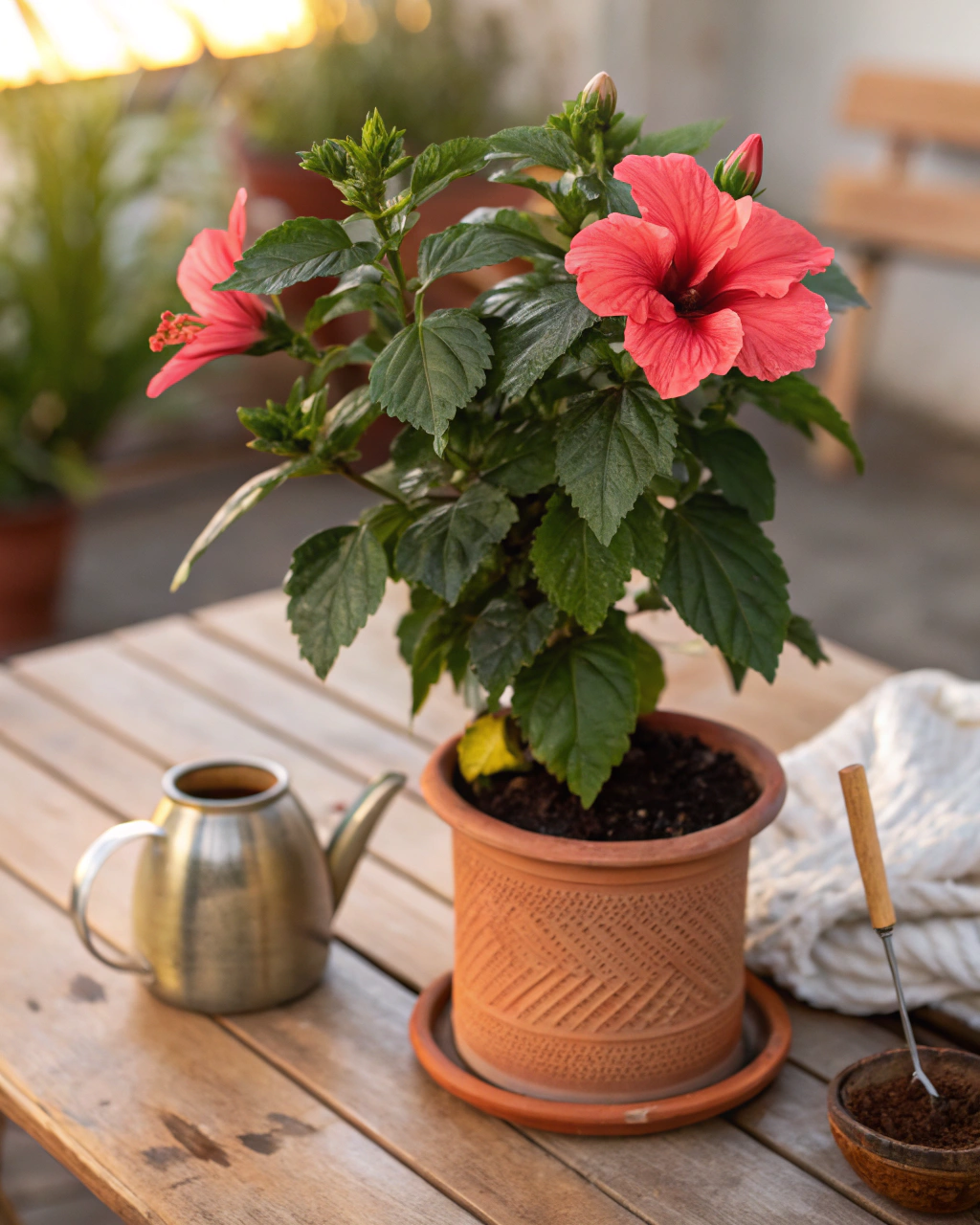Why Grow Hibiscus in Pots for Herbal Tea Lovers?
If you love herbal tea, growing your own hibiscus is one of the most rewarding choices you can make. This vibrant plant delivers deep crimson flowers packed with tart, citrusy flavor perfect for refreshing teas. Whether you have a tiny balcony, a sunny windowsill, or a modest patio, you can successfully cultivate hibiscus in pots — no sprawling garden needed. And the best part? You control the freshness, the growing conditions, and the harvest schedule, ensuring a richer tea experience than store-bought ever can. Follow my straightforward, practical steps, and soon you’ll be sipping your own homegrown herbal infusion — healthy, flavorful, and deeply satisfying.
Getting Ready — What You’ll Need
Before planting, gather these essentials carefully. Each plays a key role in your hibiscus’s success:
- Container: Choose a pot at least 30 cm (12 in) deep and 30 cm wide. This depth allows roots space to flourish. (If your area gets very hot, clay pots help keep roots cooler.)
- Drainage: Ensure the pot has adequate holes to avoid waterlogging. Waterlogged roots lead to rot quickly.
- Soil: Use a loose, well-draining soil mix of 70% loam, 20% compost, and 10% coarse sand or perlite. This blend balances moisture retention and airflow.
- Fertilizer: A balanced, low-nitrogen fertilizer works best — for example, a formula with an N-P-K ratio around 5-10-10. (Organic choices like fish emulsion or compost tea are excellent and eco-friendly.)
- Lighting: Hibiscus thrives with 6–8 hours of direct sunlight daily. A south-facing balcony or sunny window is ideal.
- Seeds or seedlings: Choose from varieties like Hibiscus sabdariffa (often called Roselle) for tea purposes. Seedlings speed the process; seeds offer more control.
- Essential tools: Gardening gloves, a small trowel, watering can with a gentle spout, and a soil moisture meter (optional but helpful).
(Low-budget substitute tip: reuse old containers with extra drainage holes drilled. Use kitchen scraps for compost and collect rainwater for watering.)
Step-by-Step — How to Grow Hibiscus in Pots
1. Preparing Your Pot
First, clean your pot thoroughly — soap and water will remove any residues or pests hiding from previous seasons. Next, place a 2–3 cm (0.8–1.2 in) layer of small pebbles or broken pottery shards at the bottom to create a drainage layer. This prevents soil from blocking the holes and helps excess water escape easily.
Fill your pot with your prepared soil mix, leaving 3–4 cm (1.2–1.6 in) space from the rim to avoid spills when watering. The soil should feel like a wrung-out sponge — moist but not dripping. Avoid packing the soil tightly; roots need air to spread. Compact soil restricts growth and invites rot.
One key mistake to avoid: Never use garden soil straight from the yard. It’s often too dense and can harbor diseases or pests — plus poor drainage leads to soggy roots.
2. Sowing or Planting
If starting from seed, soak the seeds overnight in warm water around 24–27°C (75–80°F). This softens the tough seed coat and speeds germination. Sow seeds about 0.5–1 cm (0.2–0.4 in) deep, spaced evenly if planting several in one pot. Keep soil moist but not wet.
If planting seedlings, gently loosen the roots, place the plant in the soil so that the root ball is just below the surface, and firm the soil lightly around. Maintain spacing of at least 15 cm (6 in) between seedlings to allow airflow.
Look for firm, smooth, and moist soil with no puddles. When the temperature is steady around 21–27°C (70–80°F), conditions are ideal. You’ll notice seedlings sprouting within 7–14 days.
Pro tip: Start seeds indoors for better temperature control, then transplant after the last frost. This prevents young plants from shock.
3. Watering and Sunlight
Water deeply each time you irrigate — soak the soil until water escapes at the pot’s base. In warm weather, plan for watering about 2–3 times per week. Feel the soil to decide; the top 2 cm (0.8 in) should be dry before watering again.
Too little water stresses the plant, slowing growth and flower production; too much causes root rot. In sunny, dry, or windy spots, group your pots together to create a small microclimate with shared humidity. Mulch the soil surface with straw or leaves to reduce evaporation.
Hibiscus prefers 6 to 8 hours of direct sunlight daily. In grayer climates, supplement natural light with grow lights or place the pot in the brightest window. In intense heat over 35°C (95°F), provide partial shade in the afternoon to avoid leaf scorch.
4. Feeding and Maintenance
Feed your hibiscus once every 3 to 4 weeks with a low-nitrogen fertilizer, especially during active growth and flowering stages. Excess nitrogen causes leafy growth but few flowers — balance is key.
Thin crowded seedlings or prune leggy branches to encourage bushier growth. Regularly check soil aeration by gently loosening the surface with a small tool to prevent crusting that impedes oxygen flow.
Keep an eye on leaf color and texture. Pale or yellowing leaves may indicate nutrient imbalance or overwatering. If you notice drooping or soft leaves, check soil moisture; soggy roots need less water.
“The secret is not more work — it’s regular care and observation.” — from years of hands-on experience, I’ve learned this truth well.
5. Troubleshooting While They Grow
- Yellow leaves: Usually excess nitrogen. Switch to fertilizer higher in phosphorus and potassium to promote flowering.
- Stunted growth: Not enough light. Move your pot to a sunnier spot (south or west-facing if possible).
- Pest damage: Look for small aphids or spider mites. Use insecticidal soap or neem oil promptly and spray under leaves where they hide.
- Root issues: If growth slows and soil stays soggy, check pot drainage and don’t water again until surface dries.
- Leaf drop: Can result from sudden temperature changes or drafts. Keep plants in stable, warm conditions—avoid windows that open suddenly in cold weather.
6. Harvesting
Your hibiscus flowers will reach harvest readiness around 70–90 days after planting, depending on growing conditions. The blooms should be fully open, vibrant red, and slightly firm to the touch but not brittle. Their texture feels velvety smooth, and the scent is subtly tart and fresh.
To improve flavor, reduce watering one week before harvest — this concentrates the plant’s sugars and acids. Gently pinch off flowers with your fingers or use clean scissors to avoid damaging new buds or stems.
Dry flowers quickly on a mesh screen in a dark, cool area (around 20°C/68°F) with good airflow. Store dried petals in airtight containers at about 4–7°C (39–45°F) for up to 2 weeks without loss of flavor. Alternatively, freeze dried petals in sealed bags for longer preservation.
Extra Tips for Perfect Results
- Plant companion herbs like mint, basil, lemon balm, or chamomile nearby to attract beneficial insects and improve pest resistance.
- Rotate your pots each season to prevent soil exhaustion and pest buildup.
- Mulch soil surfaces with straw, shredded leaves, or bark to retain moisture and regulate soil temperature.
- Use rainwater when possible. Tap water can increase soil hardness and pH over time.
- In windy locations, cluster pots together to reduce stress and conserve moisture.
- During intense midday sun, drape a lightweight, breathable fabric over your pots to reduce heat stress on leaves and roots.
Common Mistakes and How to Fix Them
- Overwatering: Rotting roots and soft stem bases. Solution: Let the top 2 cm (0.8 in) dry before watering again. Use pots with good drainage.
- Weak growth: Insufficient light. Move your pot to a brighter, sunnier spot to promote photosynthesis.
- Yellow leaves: High nitrogen levels promote leaf growth but suppress flowering. Use fertilizer with lower nitrogen and higher phosphorus to stimulate blooms.
- Poor germination: Seeds planted too deep will fail to sprout. Keep seed depth between 0.5–1 cm (0.2–0.4 in).
- Misshapen roots: Dense, compacted soil reduces oxygen and encourages root deformation. Always mix in coarse sand or perlite to maintain airflow in the root zone.
Harvest and Storage
Harvest your hibiscus flowers gently by pinching or cutting just below the calyx. Avoid tugging to prevent damaging tender branches and future blooms. Early morning, once dew has dried, is best for picking — the flowers retain maximum flavor and moisture.
Store fresh blooms in a cool, dark place between 4–7°C (39–45°F) for up to 2 weeks without losing aroma. For longer storage, dry flowers on a mesh rack indoors with good air circulation, then keep them airtight.
You can also preserve hibiscus by freezing or pickling the petals in vinegar and spices — both extend shelf life while intensifying flavor for teas and syrups.
Save seeds from mature seed pods by letting pods dry on the plant until they crack open naturally. Harvest seeds carefully, air-dry them for a week, then store in a cool, dry place to sow next season.
What Success Looks Like
When you pull your first firm, ruby-red hibiscus flower from your pot, you’ll feel a quiet satisfaction — a reward for every early morning observation, every careful watering, every pruning snip. This plant is generous, giving you about 20–30 flowers per plant per season in a single pot, enough for several refreshing cups of tea weekly.
The rich, tangy aroma of fresh-picked hibiscus turns simple water into a ritual. You’ll notice how your patience and attentive care have nurtured more than just a plant — they’ve deepened your connection to nature’s rhythms.
Mini Recap — Your Success Checklist
- Pot depth: Minimum 30 cm (12 in) for healthy root growth.
- Soil mix: 70% loam, 20% compost, 10% sand for proper drainage and nutrients.
- Watering: Deep soak 2–3 times per week, depending on temperature and soil feel.
- Sunlight: 6–8 hours per day of direct, bright light.
- Fertilizer: Feed every 3–4 weeks with low nitrogen, higher phosphorus mix.
- Harvest: Flowers ready in 70–90 days after sowing.
Closing Reflection
Remember, successful gardening isn’t about perfection; it’s about attention, patience, and small, consistent acts of care. Each day you tend your hibiscus, you build knowledge and confidence. Every bloom is a small victory and a reminder that nature responds beautifully to kindness and observation. So don’t rush, watch your herb grow, and take pride in the rich, silky tea that comes from your hard work. That’s real gardening — and you’re already well on your way.

Hi there — I’m Ava, the creator behind Ava Garden Tips 🌿
I’ve always been passionate about plants, flowers, and the simple joy that comes from growing something beautiful. What started as a small balcony garden has turned into a love for helping others create their own green spaces — no matter how big or small.
